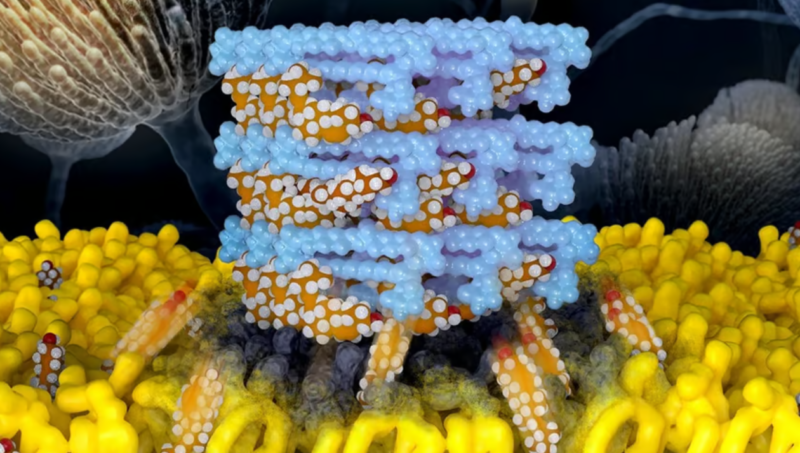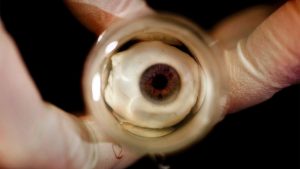Designing a safer antifungal drug

December 5, 2023
At a Glance
- Using information gleaned from atomic-level structures, researchers altered a toxic anti-fungal drug to make it safer and more effective.
- The new compound eradicated several strains of dangerous fungi in mice without serious side effects, but still needs to be tested in people.
Though viruses and bacteria hog the headlines, fungi can also cause serious illness. Every year, more than 1.5 million people worldwide die of a fungal infection. Fungi tend not to harm healthy people. But those with a suppressed immune system—such as after an organ transplant—are vulnerable to serious fungal infections. Fungi are also a dangerous source of hospital-acquired infections around the world.
Some of the currently available drugs used to kill fungi are becoming less effective as fungi develop resistance to them. Many of the remaining drugs are highly toxic, limiting their use.
One of these drugs, amphotericin B (AmB), is based on a natural product produced by bacteria. AmB may be given as a last option when other antifungal drugs have failed. But it damages cells in the kidneys, limiting the dose that can be used.
For several years, a research team led by Dr. Martin Burke from the University of Illinois Urbana-Champaign has been working to understand how AmB functions. The scientists hoped to harness that knowledge to reduce its toxicity. Until recently, researchers thought that AmB killed fungal cells by forming holes in their cell membranes. But Burke and his team discovered that AmB actually works by drawing a fungal molecule similar to cholesterol, called ergosterol, out of the membranes. This results in cellular damage and death.
The team discovered that AmB does the same thing to cholesterol in human cells, causing the damage observed in kidneys. In a new study, funded in part by NIH, the scientists altered AmB to better grab ergosterol while leaving cholesterol intact. Their results were published on November 8, 2023, in Nature.
The researchers first used atomic-level imaging to understand the structure of AmB bound to both ergosterol and cholesterol. Based on this information, they altered the structure of AmB so that it could no longer bind to cholesterol, but maintained its affinity for ergosterol.
The new compound was virtually non-toxic when tested in cells and mice, but it was less potent than AmB because it removed ergosterol from fungal cell membranes less rapidly. This gave the fungal cells time to produce enough extra ergosterol to survive.
To improve efficacy, the researchers made another tweak to the structure so that it pulled ergosterol from fungal cell membranes more quickly. The resulting compound, called AM-2-19, drew ergosterol from fungal cells rapidly but left cholesterol unaffected.
AM-2-19 proved to be safe when given in high doses to human cells and mice. Crucially, it was also as or more effective than AmB against more than 500 strains of pathogenic fungi. When tested against several potentially deadly fungal pathogens in mice, including members of the Candida, Aspergillus, and Rhizopus families, AM-2-19 eradicated several strains entirely at high doses.
“This work is a demonstration that, by going deep into the fundamental science, you can take a billion-year head start from nature and turn it into something that hopefully is going to have a big impact on human health,” Burke says. “We are very excited about the potential we are seeing, although clinical study is needed to see if this potential translates to people.”
AM-2-19 has been licensed to Sfunga Therapeutics and recently entered a phase 1 clinical trial.
—by Sharon Reynolds
Related Links
References: Tuning sterol extraction kinetics yields a renal-sparing polyene antifungal. Maji A, Soutar CP, Zhang J, Lewandowska A, Uno BE, Yan S, Shelke Y, Murhade G, Nimerovsky E, Borcik CG, Arango AS, Lange JD, Marin-Toledo JP, Lyu Y, Bailey KL, Roady PJ, Holler JT, Khandelwal A, SantaMaria AM, Sanchez H, Juvvadi PR, Johns G, Hageman MJ, Krise J, Gebremariam T, Youssef EG, Bartizal K, Marr KA, Steinbach WJ, Ibrahim AS, Patterson TF, Wiederhold NP, Andes DR, Pogorelov TV, Schwieters CD, Fan TM, Rienstra CM, Burke MD. Nature. 2023 Nov;623(7989):1079-1085. doi: 10.1038/s41586-023-06710-4. Epub 2023 Nov 8. PMID: 37938782.
Funding: NIH’s National Institute of Allergy and Infectious Diseases (NIAID) and National Institute of General Medical Sciences (NIGMS); Roy J. Carver Charitable Trust; Sfunga Therapeutics.







